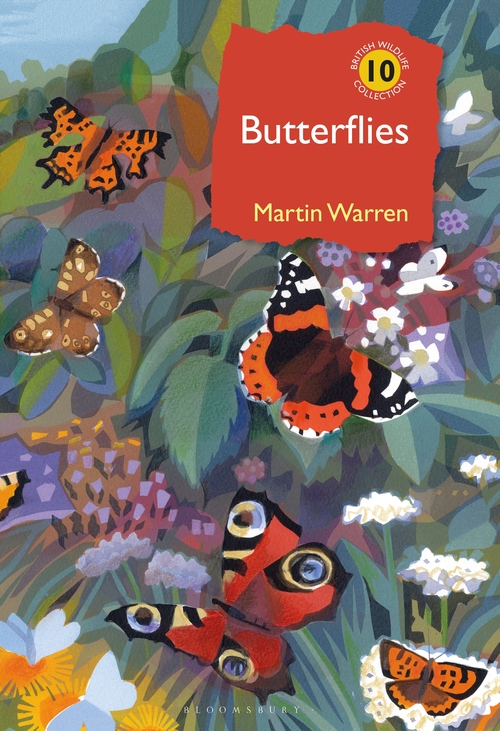 |
by Martin Warren
This new addition to the British Wildlife Collection is a unique take on butterfly behaviour and ecology, written by the former Chief Executive of Butterfly Conservation, Martin Warren. It explores the secret lives of our British species (also drawing on comparative examples from continental Europe), revealing how they have become adapted to survive in such a highly competitive natural world.
Combining personal anecdote with the latest discoveries in the scientific literature, this book covers everything from why we love butterflies and their life-cycle from egg to adult, to their struggle for survival in a world of predators and parasites and the miracle of migration. The final chapters explore how butterflies are recorded, the change in their ranges and abundance during the 20th and 21st centuries, and the significance of managing habitats at a landscape scale, concluding with a passionate plea for why we must act now to reverse butterfly declines.
Insightful, inspiring and a joy to read, Butterflies is the culmination of a lifetime of careful research into what makes these beautiful insects tick and how and why we must conserve them.
Disclosure: I reviewed each of the chapters as they were written, and have contributed a number of images to the final work. That being said, I'm not sure that this would change my review below!
The first thing to know about this book is its author - Martin Warren is not only a former Chief Executive of Butterfly Conservation, a fledgling organisation he helped grow from its first shoots of success to a membership of over 30,000 members, but is also the author or co-author of numerous scientific papers and books. He is also a founder of Butterfly Conservation Europe that now covers 35 countries across Europe. He won the Marsh Award for Insect Conservation from the Royal Entomological Society in 2007 and was voted one of the top 10 British conservationists by BBC Wildlife Magazine. He was also awarded an OBE for services to the Environment in the Queen’s New Year’s Honours in 2017. I think it's fair to say that Martin 'knows his stuff'.
 |
I must own over a hundred butterfly books, and there are always a few that stand out - those that I constantly refer to because of the incredible amount of detail that is packed into them - and this is such a work. While the author has written numerous publications in the past, this is the first that I believe will have a broad reach, appealing to both amateurs and professionals alike. I would have to say that the most comparable book I have in my collection is also, coincidentally, entitled 'Butterflies' - the seminal work that is the first in the New Naturalist series by the great E.B. Ford, published in 1945.
This book might equally be entitled 'Everything you wanted to know about butterflies but were afraid to ask' which, admittedly, is a mouthful, but this does at least convey the book's intent. This is a very different publication to most others and covers a wide variety of topics that make for an enjoyable read, with salient points punctuated with stunning images from butterfly enthusiasts and scientists from around the world - the full-page image of a Wood White emerging from its chrysalis in the wild, taken by Dave Miller, is truly amazing, as is that of a Spotted Flycatcher with a Ringlet in its mouth, taken by Andrew Fusek Peters. I think the contents listing is the best indication of this variety and, at least, helps me rationalise why I need yet another butterfly book added to my collection. The book is choc-a-bloc full of interesting facts, each of which answers a particular question that the author has posed. A smattering of facts is given below, aligned with each chapter, to give you an idea of what's in store:
There are also five appendices covering: the checklist used; the number of generations and foodplants of each species; the main habitats and their management; parasitoids; and where to see each species. Each appendix makes for an interesting read in its own right. The book is also seriously enlightening when it comes to the link between ecology and conservation. Furthermore, it is brutally and refreshingly honest in terms of good and bad, what we know and what we don't, and successes and failures.
This review has barely scratched the surface of the subject matter covered by this book and I can't but feel that I've done the author a disservice since he raises so many important questions - "are we hurtling towards an 'insect apocalypse'?". The author 'tops and tails' this work by discussing the place that butterflies have in our consciousness - they are perceived as objects of desire and wellbeing currently, but will they become objects of pity? This is a serious piece of work, with serious detail, and serious messages. I like to think that I'm someone who is always willing to learn, and I've had some great teachers, and this book is an education unto itself. The chapter 'A changing world' really touched me - especially the damage that neonicotinoids are doing (and future pesticides will do) with respect to our insect fauna (and, ultimately, us).
What comes across loud and clear, however, is the author's love for the Lepidoptera to which he has dedicated his working life, and the potential for each of us to make a difference. I remember interviewing the author back in 2006: "There are a lot of reasons to give up, but I'm an optimist and I think we really can do things to reverse decline and save threatened species. So I admire anyone who thinks that too and is prepared to do something about it". It's good to see that Martin's optimism hasn't diminished and I, for one, feel newly invigorated to fight the good fight. Suffice to say, this book is highly recommended.